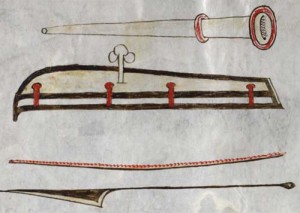By Marri Lynn (W&M Regular Contributor)
When one thinks of the gruesome injuries that could befall a knight in service, one usually thinks of crushed skulls, arrows through the ribs, and unfortunate liaisons between necks and the pointy ends of spears.
John Arderne, a fourteenth-century English surgeon, acquired plenty of experience dealing with these textbook wounds during his service in the Hundred Years War. But he also acquired a particular expertise in treating another knightly occupational hazard which was as uncomfortable for one’s pride as it was for one’s backside. If the infection down south went south metaphorically, the condition could also prove fatal.
John was the first practitioner specializing in the treatment of fistula in ano, which is, unfortunately, precisely what you’d imagine. John’s skills provided many patients from all walks of life, not just knights, with long-term relief. Like modern blue-collar workers stuck behind desks all day while habitually consuming high-fat, low-fiber diets, medieval business folk, scholars, and priests suffered too, and comprised a great portion of John’s patient list. Through prolific operations, many of which were pro bono, John earned himself a reputation in addition to a considerable salary, one gained chiefly through the bills he presented the wealthier patients who paid more dearly on John’s sliding scale.
In modern parlance, fistula in ano is an ischio-rectal abscess in the anal glands, produced by a handful of factors compounded by long hours in a saddle or a chair. It can lead to perforation of the connective tissue between the anal canal and the body’s exterior. When this happens, a passageway is formed which opens up through the perianal skin, suppurating and inviting infection. The social and medical complications caused by a fistula’s tunnel-like annexation of the human sewer system are fairly apparent, but despite this, the condition was under-treated in John’s time.
Surgeons since at least Albucasis in the eleventh century were equipped with the necessary medical and surgical theory required to treat fistulae, but they were understandably loathe to handle the long line of unfortunates seeking relief. The job was frankly inglorious, messy, and it was usually futile as well. Despite the best professionally-advised caustic ointments and prayers in addition to the use of the blade, fistulae and attendant infections had a tendency to return with a vengeance after being improperly excised. In the context of a battle for professional legitimacy, fourteenth-century English surgeons facing little promise of adequate remuneration from their clientele alongside further risk of losing good standing in the community for appearing incompetent typically chose to avoid these cases whenever possible.
John Arderne’s unusual success in treating fistulae became a selling point for his services, and a catapult for his career. By avoiding the use of caustics in his surgical aftercare and by carefully attending and learning from his successive operational experiences, John obtained – and liberally advertised – a high surgical success rate. His skill, and his Latin, enabled him to join a select group of surgeons in England who could call themselves Magister, obtaining within the Guild of Surgeons a professional and social rank which was still below the physician, but adequately above that of the mere barber-surgeon.
In his writings, John leaves the sense of a man who is far from the character one might expect necessary to hedge one’s reputation on backsides and their ills. Well-traveled, shrewd, and educated through his experiences more than through dusty halls, John’s style was emulated and his name repeated by subsequent writers like the Cambridge physician Johannis Argentin. Hardly a one-trick pony, when he wasn’t building on surgical techniques and improving the quality of life for fistulae sufferers, John practiced pharmacy, and has left behind evidence of a considerable knowledge of herbs and their applications. Indeed, following his death in the late fourteenth century, his name carried on more commonly in connection with this less pun-worthy pursuit.
Fortunately for his patients suffering from fistulae and the surgical correction thereof, John also devised and employed an analgesic ointment consisting of no less powerful stuff than hemlock, opium, and henbane.
If one so desires a more detailed account of the surgical treatment of fistula in ano (and who could resist), there is an English translation and reprint of John’s Treatises of Fistula In Ano: Haemorrhoids, and Clysters produced by Elibron Classics.
Marri Lynn holds an MA in the History of Medicine at McGill University, Montreal (2011). She is currently studying French, while freelancing as a writer and copy editor. You can find out more at her About.me page.

